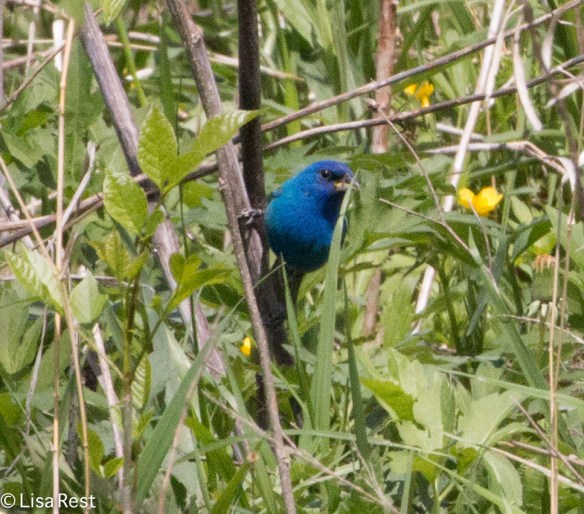
I had a lot of other photographs I was going to post from previous visits but they will have to wait. In spite of the rainy forecast Saturday morning, I went to the Portage and even though it was overcast, it was magical. Within a minute or two I had heard 10 bird species. I saw most of them and many more.

Perhaps the first bird I saw and heard was a Baltimore Oriole. There were easily half a dozen males staking out territories. This was the only one sitting out in the open.

I encountered a small flock of warblers fairly early. I was lucky to be able to sit on a big fallen log that has become permanent enough to attract graffiti. The opportunity to sit and look up into the trees was welcome. Below, couple Yellow-rumped Warblers.





I encountered small groups of White-Crowned Sparrows. They were delightful to see, but they weren’t singing. I have had them in my yard for a couple weeks and they have always started singing the minute I open the door. It was nice enough of these guys to pose for pictures.







I’ve been hearing Yellow Warblers for a couple weeks but hadn’t seen one yet at the Portage. But I found this one in my photos.

And then, of course, the Indigo Buntings. I underestimated their ability to look gorgeous even in poor light.





Below is a series of Black-and-White Warblers. There have been times I haven’t been able to capture these guys and girls, so this was a real treat for me.














I think I’ve decided Hackberries are my favorite trees. The birds like them a lot, and the Portage now seems to be full of them. They are in the elm family and I suspect were planted to fill the gaps left by all the elms we lost over the years to Dutch Elm Disease.

Here’s a Black-capped Chickadee demonstrating why he likes Hackberries. They seem to attract good worms.



A few birds I would expect to see all summer…




There were at least 30 swallows over the water. I had three species – Tree Swallows, Barn Swallows and Northern Rough-winged Swallows. They are all represented in the slide show below.
I looked up and saw this Scarlet Tanager. I’m going back to see if I can find another.



I always hear at least one White-Breasted Nuthatch but I haven’t seen any for quite a while. This one made up for all the ones I missed.






Here’s what a Magnolia Warbler might look like straight above you. Below I have grouped several views of the “Maggies” who always seem to engage with the camera.







There were some barely-there birds…



With one more Magnolia Warbler photo, I am done with this post. We are going to get warm over the next few days. I wish I didn’t have to work, it would be ideal weather to see more birds. But the somewhat crummy weather this morning created conditions for some nice encounters with beautiful birds. I really can’t complain.
































































































































































































































































































 The three species below are Yellow, Black-and-White, and Nashville Warblers.
The three species below are Yellow, Black-and-White, and Nashville Warblers.


















 House Sparrows are also capable of aerial feats.
House Sparrows are also capable of aerial feats.







 The Common Milkweed proved to be very good for Milkweed Beetles.
The Common Milkweed proved to be very good for Milkweed Beetles.




 This Dark-Eyed Junco was very comfortable and happy in the yard that last sunny weekend day. I’ve never seen a Junco try to eat peanuts before. Impressive.
This Dark-Eyed Junco was very comfortable and happy in the yard that last sunny weekend day. I’ve never seen a Junco try to eat peanuts before. Impressive.


 If you are in celebrating Thanksgiving, or wherever you are, my best wishes for days filled with peace and love.
If you are in celebrating Thanksgiving, or wherever you are, my best wishes for days filled with peace and love.





 After the Black-Throated Green left, this Swamp Sparrow occupied the same spot for a moment.
After the Black-Throated Green left, this Swamp Sparrow occupied the same spot for a moment. The Black-Throated Green was unusually late for this location, so he earned a citation on the rare bird alert. But the rest of the birds were pretty predictable, like these three Mallards enjoying the open water.
The Black-Throated Green was unusually late for this location, so he earned a citation on the rare bird alert. But the rest of the birds were pretty predictable, like these three Mallards enjoying the open water. A Red-Tailed Hawk made a couple backlit appearances… If you click on the images you can see more detail.
A Red-Tailed Hawk made a couple backlit appearances… If you click on the images you can see more detail.








 And where the preserves were crowded with kinglets the previous week, I now saw only one, a Ruby-Crowned Kinglet, below.
And where the preserves were crowded with kinglets the previous week, I now saw only one, a Ruby-Crowned Kinglet, below. On the home front, after a short sprinkle but before ensuing downpours, my yard was full of House Sparrows.
On the home front, after a short sprinkle but before ensuing downpours, my yard was full of House Sparrows. But I did still have a couple White-Crowned Sparrows who now rely on me to put out some partially chewed-up spray millet sprigs in the compost.
But I did still have a couple White-Crowned Sparrows who now rely on me to put out some partially chewed-up spray millet sprigs in the compost.


 Hanging out with the House Sparrows by the back fence was a Northern Cardinal.
Hanging out with the House Sparrows by the back fence was a Northern Cardinal.
 A few House Finches managed to forage on the ground.
A few House Finches managed to forage on the ground.

